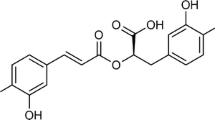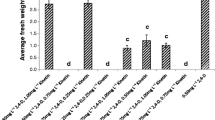Abstract
To preserve the species diversity of Rhaponticum carthamoides, a Red Book plant that is a promising source of antitumor metabolites, it is important to grow cell cultures in vitro. The aim of the work is to select the optimal nutrient medium for growing suspension cells of Rhaponticum carthamoides, varying the mineral composition of the nutrient medium and growth regulators. To obtain suspension cells in vitro, nutrient media of various mineral compositions (Murashige–Skoog, Gamborg, and Schenk–Hildebrandt) and growth regulators (auxin: 3-indoleacetic acid (IAA); cytokinin: kinetin) were used. Cultivation parameters were as follows: 26°C, 60–70% humidity, 16-h daylight period and 21-day subculture cycle. For the obtained cell cultures, the viability, growth index, and specific growth rate were assessed. The results showed that the highest values of the studied parameters were observed when growing suspension cells on a nutrient medium with a Schenck–Hildebrandt mineral composition (SH) (77–82% viability of suspension cells, 6.11‒7.14 growth index, 0.17–0.21 day–1 specific growth rate). Methanol extracts were prepared from selected and prelyophilized cell samples and analyzed by high performance liquid chromatography. The results showed that suspension cultures (the best indicators were observed in sample no. 12 grown on SH medium supplemented with IAA and kinetin), as well as the control sample (methanol extract of crushed plant root), contained sitosterol (0.26 ± 0.01 mg/g in control; 1.54 ± 0.02 mg/g in no. 12), isofraxidine (1.15 ± 0.02 mg/g in control; 3.10 ± 0.04 mg/g in no. 12), chlorogenic (44.54 ± 0.14 mg/g in control; 66.87 ± 0.02 mg/g in no. 12), and coffee (50.15 ± 0.03 mg/g in control; 54.73 ± 0.06 mg/g in no. 12) acid. The extracts of suspension cultures (100 mg/mL) exhibited antitumor properties: a cytotoxic effect on tumor cells (PANC-1, LBR2, MDAMB-231, NT-29). Cell cultures grown on SH medium supplemented with IAA and kinetin exhibited the most pronounced antitumor properties since they contained a greater amount of biologically active substances in their composition. When the extract of sample no. 12 was added, the decrease in the viability of tumor cells was achieved by 40.57–53.23%. In the course of the work, the composition of the nutrient medium was selected, which allows one to grow the biomass of suspension cultures of Rhaponticum carthamoides cells, which exhibits antitumor properties.

Similar content being viewed by others
REFERENCES
Skała, E., Synowiec, E., Kowalczyk, T., et al., Rhaponticum carthamoides transformed root extract has potent anticancer activity in human leukemia and lung adenocarcinoma cell lines, Oxid. Med. Cell. Longevity, 2018, vol. 2018, art. ID 8198652. https://www.hindawi.com/journals/omcl/2018/8198652/#copyright. Cited October 16, 2021. https://doi.org/10.1155/2018/8198652
Kokoska, L. and Janovska, D., Chemistry and pharmacology of Rhaponticum carthamoides: A review, Phytochemistry, 2009, vol. 70, no. 7, pp. 842–855. https://doi.org/10.1016/j.phytochem.2009.04.008
Solov’eva, M.A., Factors affecting the content of 20-hydroxyecdisone in Leuzea carthamoides (review), Vestn. Permsk. Fed. Issled. Tsentra, 2020, no. 4, pp. 62–75. https://doi.org/10.7242/2658-705X/2020.4.6
Havlik, J., Budesinsky, M., Kloucek, P., et al., Norsesquiterpene hydrocarbon, chemical composition and antimicrobial activity of Rhaponticum carthamoides root essential oil, Phytochemistry, 2009, vol. 70, no. 3, pp. 414–418. https://doi.org/10.1016/j.phytochem.2008.12.018
Skała, E., Toma, M., Kowalczyk, T., et al., Rhaponticum carthamoides transformed root extract inhibits human glioma cells viability, induces double strand DNA damage, H2A.X phosphorylation, and PARP1 cleavage, Cytotechnology, 2018, vol. 70, no. 6, pp. 1585–1594. https://doi.org/10.1007/s10616-018-0251-3
Skała, E., Makowczyńska, J., Wieczfinska, J., et al., Caffeoylquinic acids with potential biological activity from plant in vitro cultures as alternative sources of valuable natural products, Curr. Pharm. Des., 2020, vol. 26, no. 24, pp. 2817–2842. doi 2826666200212115826https://doi.org/10.2174/138161
Andreev, B.G., Volobaev, P.A., and Gorbunova, I.A., et al., Krasnaya kniga Kuzbassa (Red Book of Kuzbass), Kemerovo: VEKTOR-PRINT, 2021, vol. 1.
Reshetnikov, V., Spiridovich, E., Fomenko, T., et al., Plant biotechnology as a way of biosynthetic potential rational use, Nauka Innovatsii, 2014, vol. 5, no. 135, pp. 21–25.
Skała, E., Rijo, P., Garcia, C., et al., The essential oils of Rhaponticum carthamoides hairy roots and roots of soil-grown plants: chemical composition and antimicrobial, anti-inflammatory, and antioxidant activities, Oxid. Med. Cell. Longevity, 2016, vol. 2016, art. ID 8505384. https://www.hindawi. com/journals/omcl/2016/8505384/. Cited October 16, 2021. https://doi.org/10.1155/2016/8505384
Skała, E., Kicel, A., Olszewska, M.A., et al., Establishment of hairy root cultures of Rhaponticum carthamoides (Willd.) Il** for the production of biomass and caffeic acid derivatives, BioMed Res. Int., 2015, vol. 2015, art. ID 181098. https://www.hindawi.com/journals/bmri/2015/181098/ Cited October 15, 2021. https://doi.org/10.1155/2015/181098
Velichko, N.A. and Smol’nikova, Ya.V., The influence of technological parameters of extraction on the yield of extractable substances from leuzea safflower (Rhaponticum carthamoides), Vestn. Krasnoyarsk. Gos. Agrar. Univ., 2017, vol. 133, no. 10, pp. 73–78.
Sib. Gos. Tekhnol. Univ., Patent № 2130709, 1999.
Murashige, T. and Scoog, F., A Revised medium for rapid growth and bio assays with tobacco tissue culture, Physiol. Plant., 1962, vol. 15, no. 3, pp. 473–497.
Gamborg, O.L., Miller, R.A., and Ojima, O., Nutrient requirements of suspension cultures of soybean root cells, Exp. Cell Res., 1968, vol. 50, no. 1, pp. 151–158.
Asyakina, L.K., Dyshlyuk, L.S., Pozdnyakova, A.V., et al., Selection of a system for apparatus cultivation of suspension cultures of cells and root cultures in vitro in bioreactors of various designs and volumes, Vestn. Yuzhno‑Ural. Gos. Univ., Ser.: Pishch. Tekhnol., 2021, vol. 9, no. 3, pp. 41–52. https://doi.org/10.14529/food210305
Skała, E., Sitarek, P., Toma, M., et al., Inhibition of human glioma cell proliferation by altered Bax/Bcl-2-p53 expression and apoptosis induction by Rhaponticum carthamoides extracts from transformed and normal roots, J. Pharm. Pharmacol., 2016, vol. 68, no. 11, pp. 1454–1464. https://doi.org/10.1111/jphp.12619
Yang, I, Asyakina, L.K., Babich, O.O., et al., Physicochemical properties and biological activity of extracts of dried biomass of callus and suspension cells and in vitro root cultures, Tekh. Tekhnol. Pishch. Proizvod., 2020, vol. 50, no. 3, pp. 480–492. https://doi.org/10.21603/2074-9414-2020-3-480-492
Kweon, B., Han, Y.H., Kee, J.Y., et al., Effect of Angelica gigas Nakai ethanol extract and decursin on human pancreatic cancer cells, Molecules (Switzerland), 2020, vol. 25, no. 9, art. ID 2028. https://www. mdpi.com/1420-3049/25/9/2028#cite. Cited October 16, 2021. https://doi.org/10.3390/molecules25092028
Zaushintsena, A.V., Milentyeva, I.S., Babich, O.O., et al., Quantitative and qualitative profile of biologically active substances extracted from purple echinacea (Echinacea purpurea L.) growing in the Kemerovo region: functional foods application, Foods and Raw Materials, 2019, vol. 7, no. 1, pp. 84–92. https://doi.org/10.21603/2308-4057-2019-1-84-92
Sadeghi Ekbatan, S., Li, X.Q., Ghorbani, M., et al., Chlorogenic acid and its microbial metabolites exert anti-proliferative effects, S-phase cell-cycle arrest and apoptosis in human colon cancer Caco-2 cells, Int. J. Mol. Sci., 2018, vol. 19, no. 3, art. ID 723. https://www.ncbi.nlm.nih.gov/pmc/articles/PMC5877584/#. Cited October 16, 2021. https://doi.org/10.3390/ijms19030723
Author information
Authors and Affiliations
Corresponding author
Ethics declarations
CONFLICT OF INTEREST
The authors declare that they have no conflicts of interest.
COMPLIANCE WITH ETHICAL STANDARDS
The study was performed without the use of animals or people as subjects.
Additional information
Translated by P. Kuchina
About this article
Cite this article
Prosekov, A.Y., Kozlova, O.V. & Vesnina, A.D. Biotechnology of Cultivation of Rhaponticum Carthamoides (willd.) Suspension Cells: A Prospective Source of Antitumor Substances. Russ. Agricult. Sci. 48, 197–202 (2022). https://doi.org/10.3103/S1068367422030119
Received:
Revised:
Accepted:
Published:
Issue Date:
DOI: https://doi.org/10.3103/S1068367422030119




